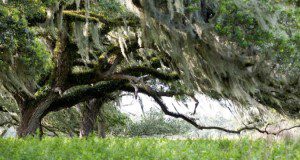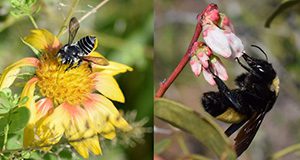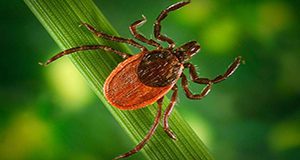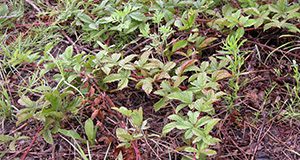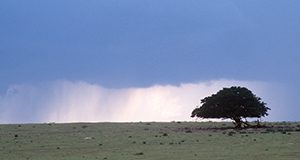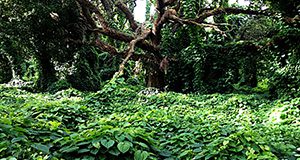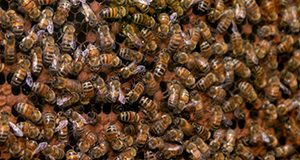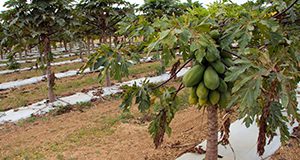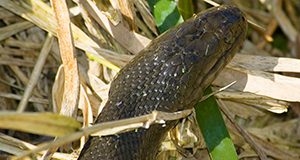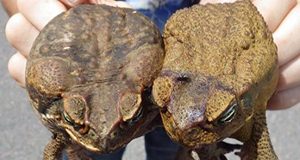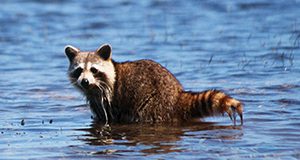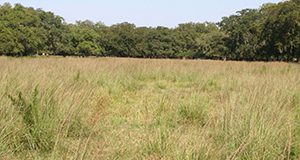The “bird’s nest” fungi (Nidulariaceae) are charismatic mushrooms that look like small nests containing multiple tiny eggs. Because the ecological role of bird’s nest fungi is to decompose wood, they are extremely common in disturbed areas with plant debris and mulch, such as trails and backyard gardens. These fungi tend to grow in large clusters, so it is common to see ten to a hundred of these “nests” at once. Bird’s nest fungi are not considered dangerous to plants, animals, or humans. This new 3-page publication of the UF/IFAS Plant Pathology Department was written by Nattapol Kraisitudomsook and Matthew E. Smith.
https://edis.ifas.ufl.edu/pp361
Category: Environment
Crop Water Use and Irrigation Scheduling Guide for North Florida
Effective irrigation scheduling enables the irrigator to apply the right amount of water at the right time to meet the crop water demand. This 19-page guide presents information on average daily and weekly crop water use and crop growth stages for twelve north Florida crops that can be used to help schedule irrigation. This will allow a grower to develop a realistic irrigation schedule that minimizes plant water stress, saves water, and reduces nutrient leaching potential. Written by Vivek Sharma, Charles Barrett, De Broughton, and Thomas Obreza, and published by the UF/IFAS Department of Soil and Water Sciences, revised December 2020.
https://edis.ifas.ufl.edu/ss491
Key Plant, Key Pests: Oak (Quercus spp.)
This series of Key Plant, Key Pests publications is designed for Florida gardeners, horticulturalists, and landscape professionals to help identify common pests associated with common Florida flora. This new 9-page publication provides information and general management recommendations for borers, caterpillars, insect-induced galls, twig girdlers, oak leaf blister, root and butt rot, Tubakia leaf spot, mistletoe, psocids, lace bugs, woolly aphids, powdery mildew, Spanish and ball moss, and lichens. Written by Juanita Popenoe, Caroline R. Warwick, Adam G. Dale, and Alfred Huo, and published by the UF/IFAS Environmental Horticulture Department.
https://edis.ifas.ufl.edu/ep596
Consejos Basicos para Disenar Sistemas Eficientes de Riego
Este documento provee un panorama básico de los factores más importantes al diseñar. Written by Haimanote K. Bayabil, Kati W. Migliaccio, Michael Dukes, Laura Vasquez, and Carlos Balerdi, and published by the UF/IFAS Department of Agricultural and Biological Engineering, December 2020.
https://edis.ifas.ufl.edu/ae549
Bees of Florida
Did you know there are over 320 species of bees in Florida and over 4,000 in the United States? Wild bees vary widely in behavior, color, size, and shape. Written by James R. Weaver, Shiala M. Naranjo, Emily Noordyke, and Rachel E. Mallinger and published by the UF/IFAS Entomology and Nematology Department, Bees of Florida is a two-page pdf guide to some common bee groups and species you may encounter in Florida.
https://edis.ifas.ufl.edu/in1285
Facts about Wildlife Diseases: Ehrlichiosis
Ehrlichiosis is a bacterial disease that is transmitted to humans and animals from ticks. In most cases, symptoms are mild, but sometimes if antibiotic treatment is delayed, it can cause severe illness and even death. In Florida, ehrlichiosis is an emerging disease. The hotspot of transmission is in north central Florida, but the disease is underdiagnosed. This 4-page fact sheet written by Yasmin Tavares and Samantha Wisely and published by the UF/IFAS Department of Wildlife Ecology and Conservation describes ehrlichiosis and explains how it is transmitted, how to know if you have it, and how to prevent yourself and your friends and family from getting it.
https://edis.ifas.ufl.edu/uw481
Blackberry and Dewberry: Biology and Control
Blackberry and dewberry are often viewed as nuisance weeds that reduce grazing in a portion of the pasture. However, severe financial losses can occur if these growing thickets injure cattle. This 4-page document provides information regarding blackberry and dewberry management in pastures. Written by Brent Sellers, Pratap Devkota, and Jason Ferrell, and published by the UF/IFAS Agronomy Department, revised November 2020.
https://edis.ifas.ufl.edu/ag238
How Is Our Future Climate Projected?
Climate is the long-term patterns and fluctuations in air and moisture. This 5-page article explains how future climate is projected using mathematical models and introduces common scientific terms used when discussing climate change. Written by Young Gu Her, Zachary Brym, Ashley Smyth, and Elias Bassil, and published by the UF/IFAS Department of Agricultural and Biological Engineering, November 2020.
https://edis.ifas.ufl.edu/ae546
¿Perdidos en la maleza? Una guia exhaustiva de malas hierbas no autoctonas en Florida
Este artículo tiene como objetivo informar al público en general, administradores de tierras, investigadores, autoridades locales y estatales, y a todo aquel que busque orientación para acceder a listados de plantas no autóctonas en el estado de Florida, tanto normativos como no normativos. En este documento se explica el origen de las listas, el significado de la inclusión en una lista en concreto y la forma de acceder a cada una de ellas. Written by Deah Lieurance, Lyn A. Gettys, and Germán Sandoya-Miranda, and published by the UF/IFAS Agronomy Department, November 2020.
https://edis.ifas.ufl.edu/ag444
Best Management Practices for Live Bee Removals in Florida: A Beekeeper’s Guide
Feral colonies of honey bees nesting near humans or domestic animals can pose a stinging threat and may be considered a nuisance and possibly a threat to animal or public health, and therefore bees often need to be removed or eradicated when they are found nesting near homes or other property. This 14-page guide written by Mary Bammer, Jamie Ellis, Eric Baxter, Krista Butler, John Coldwell, B. Keith Councell, Kevin Easton, Brendhan Horne, Brandi Stanford, and Amy T. Vu and published by the UF/IFAS Entomology and Nematology Department details best management practices for live bee removals and serves as a reference for beekeepers who choose to perform live bee removal services in Florida.
https://edis.ifas.ufl.edu/in1297
Container Mosquito Habitat Community Cleanup: A How-To Guide for Event Organization
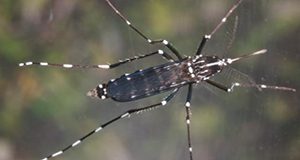
Being bitten by the container mosquitoes Aedes aegypti and Ae. albopictus means a higher risk of becoming infected with Zika, dengue, or chikungunya virus. Container mosquitoes develop in the water that collects in discarded tires, jars, cans, buckets, and boats. The best way to prevent irritating bites and dangerous mosquito-transmitted illnesses is to get rid of all trash that holds water. This 6-page fact sheet written by Amy Hallock, Eva A. Buckner, Ricky W. Telg, and Alena R. Poulin and published by the UF/IFAS Entomology and Nematology Department is packed with recommendations that will help you to successfully develop and host a cleanup event to reduce potential mosquito larval habitats in your community and keep yourself and your neighbors safe.
https://edis.ifas.ufl.edu/in1286
Programacion de Riego Basado en el Metodo de Evapotranspiracion Para Papaya (Carica papaya) en Florida
La papaya es un importante cultivo frutícola que se cultiva en el sur de Florida con un área estimada de 356 acres. Este documento se centra en las técnicas de programación de riego basadas en ET para la papaya en las condiciones de Florida. Written by Haimanote K. Bayabil, Jonathan H. Crane, Kati W. Migliaccio, Yuncong Li, Fredy Ballen, and Sandra Guzmán, and published by the UF/IFAS Department of Agricultural and Biological Engineering, November 2020.
https://edis.ifas.ufl.edu/ae547
Eastern Indigo Snake
Learn more about eastern indigo snakes!
The Wildlife of Florida Factsheet series was created to provide the public with a quick, accurate introduction to Florida's wildlife, including both native and invasive species. Authors Tyler Buckley and Raoul K. Boughton hope this 2-page quick guide and others in the series published by the UF/IFAS Department of Wildlife Ecology and Conservation will inspire readers to investigate wildlife in their own backyards and communities and understand the amazing biodiversity of wildlife in the state of Florida.
https://edis.ifas.ufl.edu/uw475
El sapo de caña o “Bufo” (Rhinella marina) en Florida
El sapo de caña (Rhinella marina), a veces conocido como el “bufo”, sapo gigante o marino, es nativo del extremo sur de Texas, México, América Central y la zona tropical de la América del Sur, pero está establecido en Florida. Los sapos de caña se introdujeron inicialmente en Florida como un método de control biológico de plagas en la década de 1930. Se suponía que los sapos comieran escarabajos que amenazaran el cultivo de la caña de azúcar, pero la población introducida no sobrevivió. This 7-page fact sheet written by S. A. Johnson, A. Wilson, and Armando J. Ubeda and published by the UF/IFAS Department of Wildlife Ecology and Conservation is the Spanish translation of The Cane or “Bufo” Toad (Rhinella marina) in Florida.
https:edis.ifas.ufl.edu/uw477
The Life of Lichen
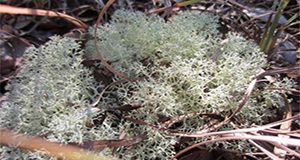
Lichen represent a fascinating combination of organisms working together to form some familiar and unfamiliar growths on a variety of substrates. This 6-page fact sheet written by James Stevenson, Lara B. Milligan, and Jennifer L. Gillett-Kaufman and published by the UF/IFAS Entomology and Nematology Department defines and explains these organisms.
https://edis.ifas.ufl.edu/in1296
Facts about Wildlife Diseases: Raccoon-Borne Pathogens of Importance to Humans—The Raccoon Roundworm
Diseases carried by northern raccoons present significant health hazards to both people and pets. This 7-page fact sheet written by Caitlin Jarvis and Mathieu Basille and published by the UF/IFAS Department of Wildlife Ecology and Conservation is part of a series addressing health hazards associated with raccoons. It describes the raccoon roundworm and the disease it causes, baylisascariasis, which normally causes little or no trouble to raccoons but in severe cases can make people and their pets very sick. Sick wild animals can act tame, but do not approach! Contact animal control or a wildlife rehabilitator if an animal seems to be behaving abnormally or if you suspect it is sick.
https://edis.ifas.ufl.edu/uw480
Facts about Wildlife Diseases: Raccoon-Borne Pathogens of Importance to Humans—Parasites
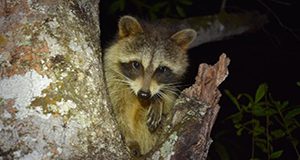
Diseases carried by northern raccoons present significant health hazards to both people and pets. This 7-page fact sheet written by Caitlin Jarvis and Mathieu Basille and published by the UF/IFAS Department of Wildlife Ecology and Conservation is part of a series addressing health hazards associated with raccoons. It describes the most important internal and external parasites associated with raccoons. Sick wild animals can act tame, but do not approach! Contact animal control or a wildlife rehabilitator if an animal seems to be behaving abnormally or if you suspect it is sick.
https://edis.ifas.ufl.edu/uw479
Facts about Wildlife Diseases: Raccoon-Borne Pathogens of Importance to Humans—Viruses and Bacteria
Diseases carried by northern raccoons present significant health hazards to both people and pets. This 7-page fact sheet written by Caitlin Jarvis, Samantha M. Wisely, and Mathieu Basille and published by the UF/IFAS Department of Wildlife Ecology and Conservation is part of a series addressing health hazards associated with raccoons. It describes rabies, canine distemper, feline distemper, canine parvovirus, salmonellosis, and several other raccoon-borne viral and bacterial diseases of concern to people and their pets. Sick wild animals can act tame, but do not approach! Contact animal control or a wildlife rehabilitator if an animal seems to be behaving abnormally or if you suspect it is sick.
https://edis.ifas.ufl.edu/uw478
Smutgrass Control in Perennial Grass Pastures
This 4-page document provides an overview of smutgrass biology, control, and general recommendations. Written by Brent Sellers, Neha Rana, José Luiz C. S. Dias, and Pratap Devkota, and published by the UF/IFAS Agronomy Department, revised October 2020.
https://edis.ifas.ufl.edu/aa261
How Are Our Future Agriculture and Natural Resources Projected under Varying Climate?
This 8-page article explains how agriculture and natural resources may respond to projected future climate and how climate projections can be useful in developing management plans for the improved sustainability of Florida's agriculture and natural resources. It also aims to help increase the public awareness of climate change impacts on Florida and improve understanding of the connections among climate, agriculture, and natural resources. Written by Young Gu Her, Ashley Smyth, Zachary Brym, and Elias Bassil, and published by the UF/IFAS Department of Agricultural and Biological Engineering, September 2020.
https://edis.ifas.ufl.edu/ae545


